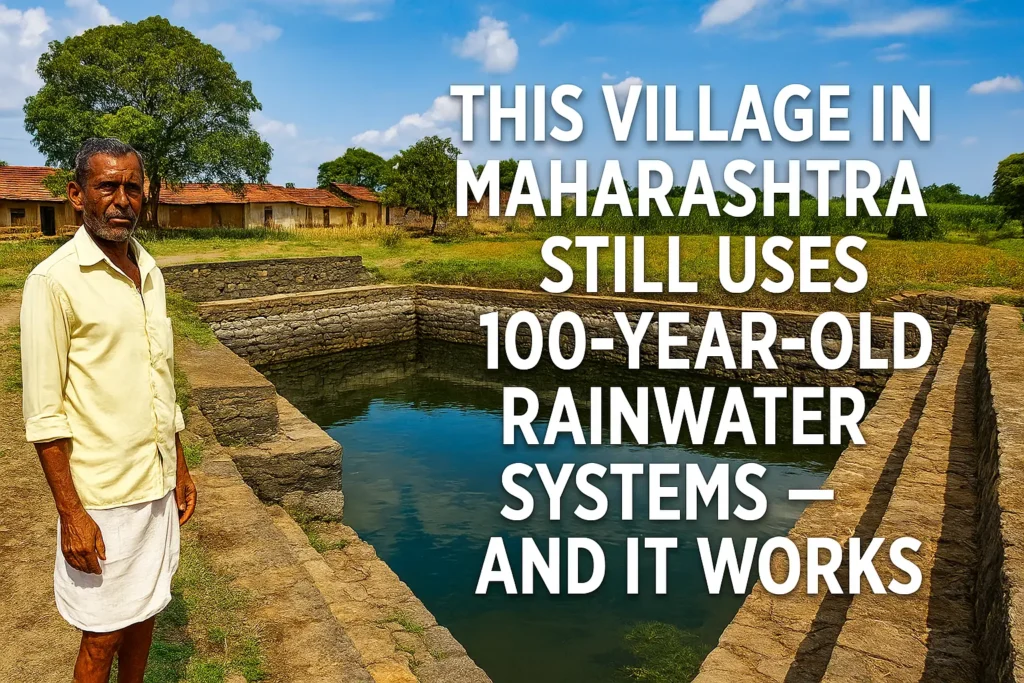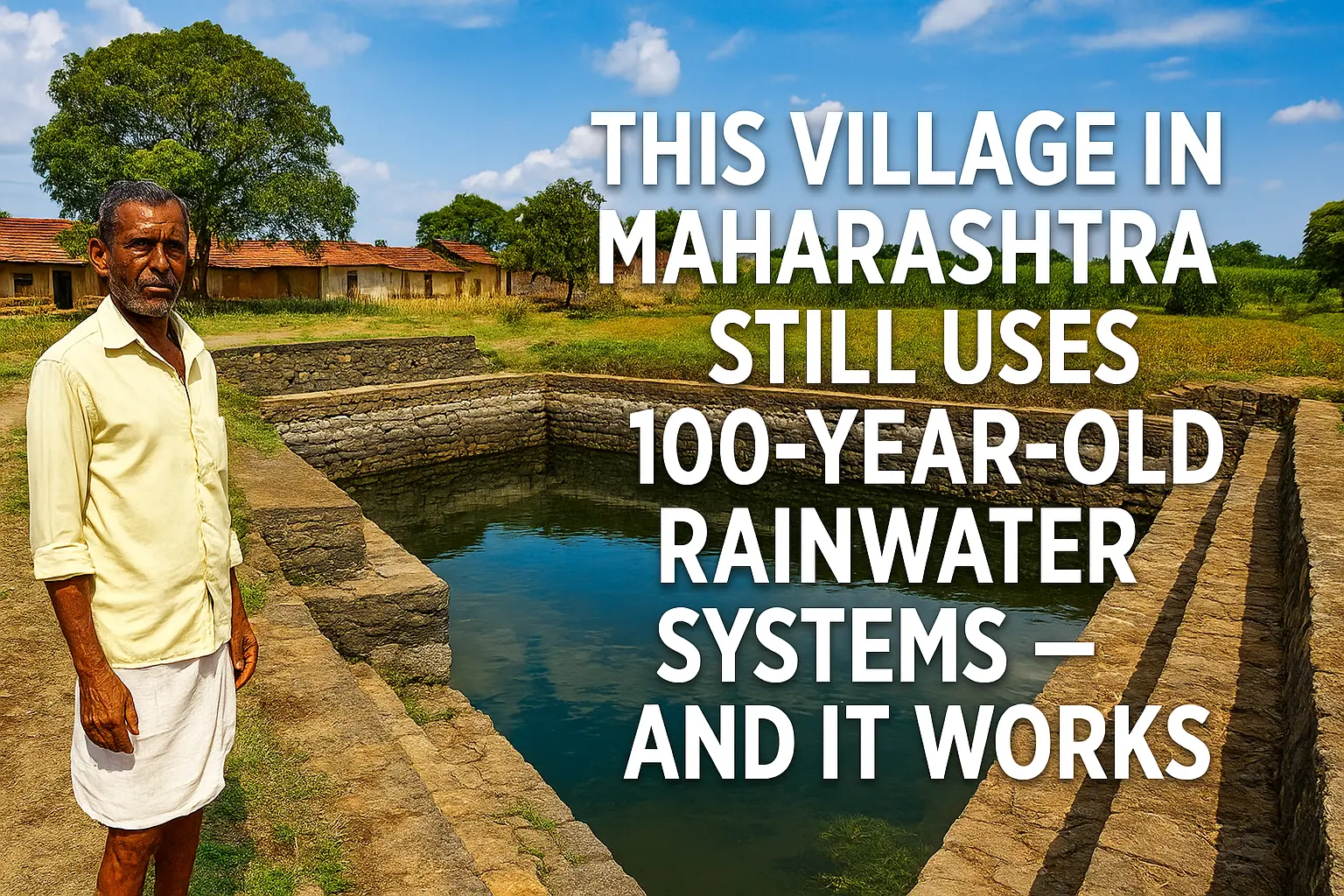In a world rapidly shifting toward digital innovation and infrastructure overhauls, some of the most effective solutions remain hidden in simplicity and tradition. Deep in the heart of Maharashtra lies a small village that has resisted modern plumbing and pumping technologies—not due to lack of access, but because its age-old water management system continues to deliver, season after season.
While water scarcity has become a defining issue for rural India, this village has quietly sustained itself using a century-old rainwater harvesting system, ingeniously designed by its ancestors. It’s not just a relic of the past; it’s a working model that holds valuable lessons for the present and the future.
Where Tradition Meets Functionality
The village of Kumbharwadi, located in Ahmednagar district, might appear ordinary at first glance. Modest homes, dusty lanes, and scattered fields define its landscape. But what sets it apart is what lies underneath—an underground network of stone tanks, channels, and gravity-fed filters that has collected, stored, and distributed rainwater for over 100 years.
The system was originally built in the early 20th century when village elders sought a sustainable way to harness seasonal rains. Over time, they designed a system of interlinked tanks and covered reservoirs that collected monsoon water from catchment areas and diverted it for year-round use.
This wasn’t just a one-time effort. It was a community-driven mission, combining observation of local terrain, indigenous engineering techniques, and cooperative labor. And to this day, that same network supports farming, household use, and drinking water needs.
How the System Works
The core of the rainwater harvesting system revolves around natural slopes, gravity, and minimal mechanical intervention. Here’s how it functions:
- Catchment Areas: Elevated lands around the village act as natural rain catchers. Rainwater is directed through stone-lined channels.
- Sedimentation Pits: As water flows in, it passes through filtration pits filled with sand and gravel, removing silt and debris.
- Underground Tanks: The filtered water flows into deep stone-lined tanks built underground. Some of these tanks are large enough to hold over 50,000 liters.
- Distribution: From these tanks, water travels via narrow channels to homes and fields, aided by gravity.
- Overflow Management: Any surplus during heavy rains is redirected to nearby ponds, preventing soil erosion and groundwater contamination.
The entire system is decentralized and operates without electricity. It’s nearly silent, invisible from the surface, and incredibly efficient.

Resilience During Drought
What makes Kumbharwadi’s rainwater system remarkable is its resilience in the face of drought. In recent years, Maharashtra has faced several water crises. Cities have struggled, farmers have migrated, and tankers have become a lifeline in many parts of the state.
But Kumbharwadi continued to thrive. During years when rainfall dropped by 30–40%, the village had enough water to sustain its population. While surrounding villages queued up for water, Kumbharwadi families cooked, cleaned, and irrigated as usual. Crops were not abandoned, and livestock didn’t perish.
The villagers credit their forefathers not just for building a system, but for cultivating a culture of water discipline. They do not waste water. Every drop is valued. They clean the tanks before monsoons, repair channels regularly, and monitor usage across seasons.
Community Ownership and Knowledge Transfer
The continued success of the 100-year-old system isn’t accidental—it thrives on community ownership. Each household contributes to its upkeep, and the village panchayat maintains records of storage levels and usage schedules.
Knowledge is passed down generationally. Children grow up understanding how the system works. Village elders conduct informal classes before each monsoon, teaching youngsters about water conservation, tank cleaning, and early-warning signs of system damage.
Unlike modern infrastructure projects where repairs depend on government departments or external contractors, here, the community knows how to fix its own system.
Lessons for Modern Water Management
Kumbharwadi’s story holds deep relevance today. As climate change disrupts rainfall patterns and urban water demands soar, planners and engineers often chase complex, high-cost solutions. But this village proves that low-tech, nature-aligned models can outperform their modern counterparts, especially in rural settings.
Key takeaways from Kumbharwadi include:
- Decentralization Works: Community-managed systems reduce dependence on external resources and are more responsive to local needs.
- Gravity Over Machinery: Systems that rely on gravity, not pumps, reduce energy costs and remain operational during blackouts.
- Maintenance Culture: When communities own infrastructure, they maintain it better and for longer.
- Design for the Terrain: Using local geography to guide design enhances efficiency and durability.
- Simplicity = Sustainability: The less complex a system is, the easier it is to manage, fix, and adapt over generations.
In fact, several NGOs and civil engineers now study Kumbharwadi’s model to replicate its principles in other drought-prone areas.
Government and Institutional Recognition
Kumbharwadi hasn’t gone unnoticed. Over the years, the village has received visits from researchers, government officials, and sustainability experts. The Maharashtra Water Resource Department has documented parts of the system as a heritage water conservation structure.
Educational institutions have invited villagers to share insights with students. A local university is currently working on creating a 3D model of the system for training rural engineers.
Despite this attention, the villagers remain humble. For them, the recognition is less important than the peace of mind that comes from not having to worry about water each summer.
The Future of Traditional Wisdom
As India races toward smart cities and climate-resilient infrastructure, it risks leaving behind a treasure trove of traditional knowledge. Villages like Kumbharwadi remind us that sustainability isn’t always about high-end technology. Sometimes, it’s about revisiting what worked—and still works—with humility and open-mindedness.
There is a growing call among environmentalists and urban planners to blend traditional systems with modern monitoring tools. Sensors can now track tank levels, mobile apps can alert villagers about rainfall forecasts, and mapping tools can enhance drainage design. But the heart of the system must remain in community hands.
Kumbharwadi’s success lies not just in stone and mud channels, but in a mindset—one that values water, trusts collective wisdom, and sees tradition not as a limitation, but as a foundation.
Final Thoughts
At a time when water is fast becoming a global crisis, this village in Maharashtra shows us that the answers may already exist, etched into the land, passed through generations, and quietly working while the rest of the world scrambles for solutions.
In the 21st century, the smartest villages might just be the ones that never stopped trusting the intelligence of the 19th.
